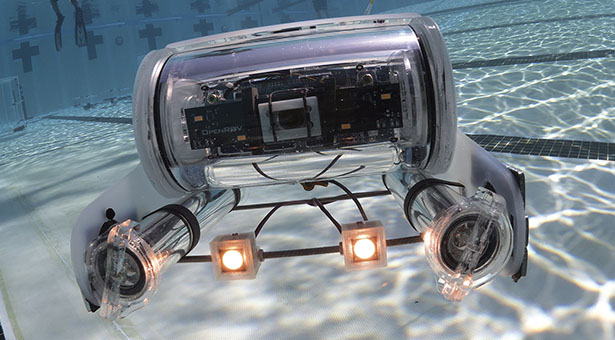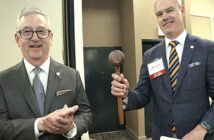Direct economic impact and long-term workforce development promise make upcoming event a win for all involved
by Scott Robertson
This summer, around 1,500 of the brightest young minds in the world will congregate at the Kingsport Aquatic Center for an international robotics competition. They will have designed and built underwater remote operated vehicles (ROVs). They will have mastered the mechanics, physics and marketing skills necessary to build a successful company. And, they will bring with them the ambition to prove they are the best in the world at what they do. They will come from Asia, Australia, Europe, the Middle East, Africa and the Americas – and, if all goes well at a regional competition in April, from Johnson City and Kingsport, Tennessee.
The Marine Advanced Technology Education (MATE) International Competition, scheduled for June 20-22, will challenge teams of students in age categories from kindergarten through college to prepare underwater robots for missions set in rivers, in lakes and at dams. It’s actually a far cry from the first MATE competitions, which were designed to teach students the skills needed to operate the ROVs that service oil rigs in the Gulf of Mexico. Over the years, the competition has moved its headquarters to California and broadened its scope to teach the skills necessary for the ocean-based workforce.
Still, how did the 2019 competition end up 400 miles inland?
To trace this stream to its source, one must look back to a meeting of two old friends in Georgia a few years ago. Dennis Courtney was playing host to his former schoolmate David Golden. Courtney was running a robotics program that helped disadvantaged minority students develop skills that would take them into college and beyond. Golden was a vice president at Eastman.
After a pleasant conversation turned into a seven-hour discussion, Golden convinced Courtney to come to Kingsport, bringing his robotics programs with him under the auspices of an organization called Streamworks, powered by Eastman in Education.

Photo by Tara Hodges, Sweet Snaps
“I have to give credit to Eastman because we wouldn’t have underwater robotics if it hadn’t been for their interest in the ocean sciences,” Courtney says. Eastman had a close relationship with the Woods Hole Oceanographic Institute. At Golden’s urging, Courtney visited Woods Hole, where he observed the institute using ROVs to study how microplastics were being introduced into the food chain.
As Eastman worked on ways to address the problem of waste plastic as part of its global sustainability initiatives, Courtney became fascinated by the underwater ROVs and how they could benefit students in the Appalachian highlands. His research led him to the MATE Center.
Courtney cold-called the MATE Center, asking if they would be interested in working with entities in Tennessee. It seemed a stretch, since MATE was created to help develop the ocean-related workforce and Kingsport is 400 miles inland, but MATE Inspiration for Innovation President Jill Zande was open to the idea.
Kingsport hosted a regional competition last year, and teams from Kingsport’s Dobyns Bennett High School and D-B Excel, a Tennessee STEM school, advanced to the International Competition in Tacoma, Wash.
Then a funny thing happened. The Massachusetts Institute of Technology (MIT) has been penciled in to host the 2019 competition, but decided that 2021 would be a better fit. That left the door open for Kingsport.
So, instead of having the teams’ ROVs perform ocean-related tasks this year, the competition will involve simulated dam repair, the observation of a river-based ecosystem and the salvaging of a Civil War era cannon from the bottom of a river.
One remarkable feature of the MATE competition is its real-life feel. Zande says the teams form companies with corporate hierarchies and separate responsibilities, from engineering to piloting to marketing. “You could build an underwater robot and it could perform well and you could be an awesome pilot. But if you can’t communicate your work and explain what you did to show that you actually learned something and understood it, I mean that’s a big piece of it for us. It’s not just about winning, it’s just not about building the robot. We really want the students to have learned and gained something, gain some skills along the way.” So, for instance, instead of just being handed a list of rules and objectives, teams will be given a request for proposals from Eastman.

Photo by Earl Neikirk
Makaila Freeman, CEO of Dobyns-Bennett’s team last year is now on staff working for Courtney at Streamworks. “We not only had to create the robot and prove we could do the tasks with it,” Freeman says, “we also had to make a 25-page technical document showing the features of the robot and a marketing presentation just like a business.”
Freeman recently met with the Science Hill High School team from Johnson City at Streamworks’ STEM Gym facility in Kingsport. A Dobyns-Bennett student helping a Science Hill team would have been anathema not too long ago, but in MATE competition, professional courtesy is encouraged, just as it is in the business world. It’s a nice display of regionalism at the very least.
That’s appropriate, Golden says, because the entire region stands to benefit from the MATE International Competition coming to the Appalachian Highlands, and not just from the short-term direct economic impact. “We don’t want this to be an Eastman event. We want this to be a regional event. If the Chambers and the business community roll out the red carpet and make the best and brightest young people in the world feel welcome here, there’s only going to be continued growth in the demand for this sort of thing.”
The competition will be livestreamed worldwide, Golden says. “It’s a great way to showcase our region.”




